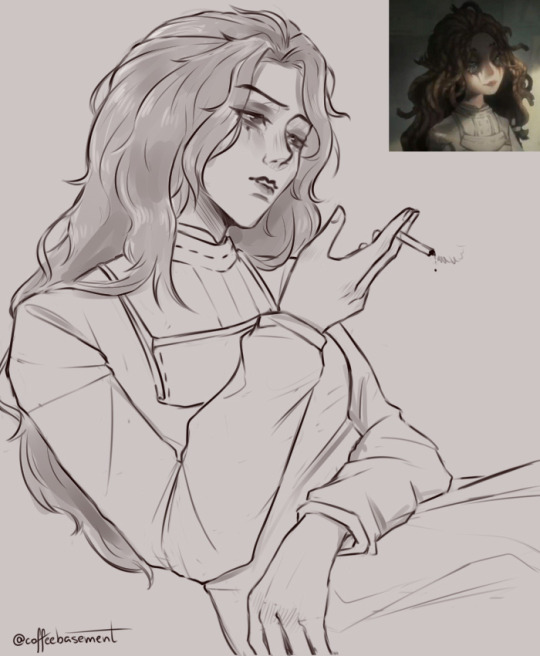#idv ada
Text
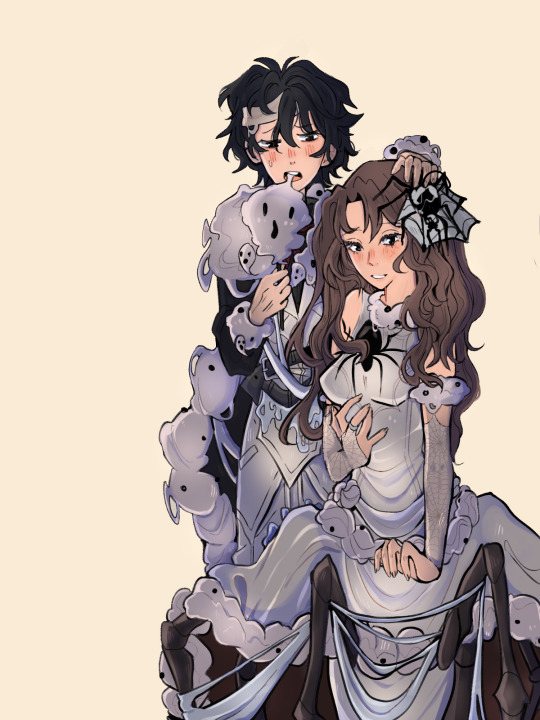
aid and email🥺(old drawing)
#idv#idv fanart#idv patient#idv psychologist#fanart#digital art#ada mesmer#emil mesmer#idv ada#idv emil#identity v#identity v fanart#adamil#ada x emil#emil x ada#ship art
109 notes
·
View notes
Text
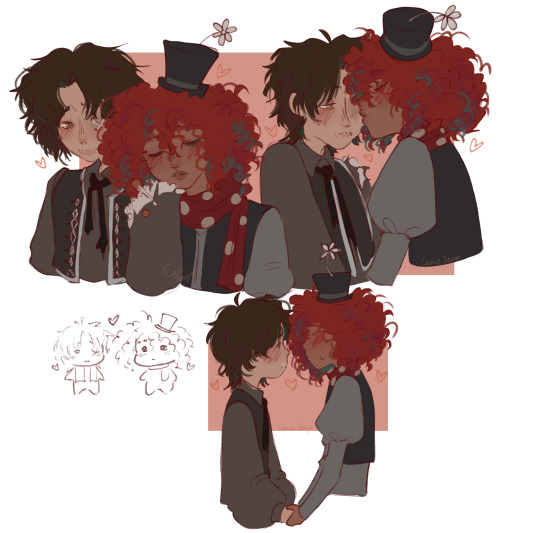




hello again tumblr... i forgot to keep postimg here im so sorry 😭😭😭 im much more active on my other socials 😢
#art#doodle#identity 5#identity v#idv#idv fanart#artists on tumblr#fanart#idv weeping clown#idv ada#idv emil#idv psychologist#idv patient#idv puppeteer#idv matthias
119 notes
·
View notes
Text

Lore of IDV but it's set in 2009
152 notes
·
View notes
Text
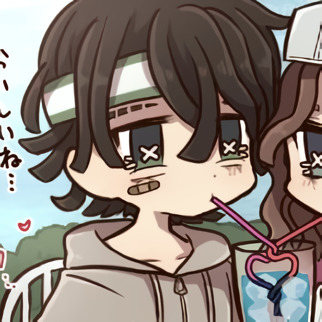





Ada and Emil matching icons; identity v
#i have brainrot of these two im sorry#identity v#idv#identity v icons#idv icons#identity v psychologist#identity v ada#identity v patient#identity v emil#idv ada#idv emil#idv psychologist#idv patient#idv matching icons#identity v matching icons
163 notes
·
View notes
Text

Pretty 🥺
#idv fanart#idv ada#idv emil#idv patient#idv psychologist#digital art#art#identity v#artists on tumblr
103 notes
·
View notes
Text

hello idv fd
57 notes
·
View notes
Text
The fixations are real for me rn.

I can't stop enjoying/playing the games.
#idv ithaqua#idv ada#idv emil#identity v#twisted wonderland#twst#disney twst#trey clover#delusional#im losing my mind with these games lol
59 notes
·
View notes
Text
[August 1, 2022]



Ms Ada Mesmer you're so sexy aha
#digital art#digital illustration#comic art#art#identity v#idv#idv fanart#identity v fanart#idv psychologist#identity v psychologist#idv ada#identity v ada#identity v ada mesmer#idv ada mesmer#ada mesmer#idv emil#identity v emil#idv patient#identity v patient#idv survivor
52 notes
·
View notes
Text
Ada Mesmer NSFW Alphabet
Warnings: nsfw, poly adaemil

A = Aftercare (what they're like after sex)
She’s gentle and tender, both during sex and after, so expect to be pampered. She does expect for you to give the same treatment and tend to her needs in return, but she won’t hold it against you if you cannot.
B = Body part (their favourite body part of theirs and also their partner's)
She likes not only the entirety of your body, but also the way you hold yourself, the subtle changes in your body language that reveal to her more than one could speak. Her favourite part of hers is her hair, as she takes great pride in keeping it voluminous and luscious.
C = Cum (anything to do with cum, basically)
Often her orgasms include squirting, and while she would try to stop it if you don’t like the mess, she can be caught up in the moment and forget to do so.
D = Dirty secret (pretty self explanatory, a dirty secret of theirs)
If you are open to a relationship between both her and Emil, then she’ll, of course, want to have a threesome sometime. There is a part of her who wants to roleplay, as well as being dominated, since Emil is unable to give her that.
E = Experience (how experienced are they? do they know what they're doing?)
Ada has good experience both with men and women, and is good at reading body language. She won’t push if she thinks you’ll be uncomfortable, and will make sure you’re not simply agreeing to please her.
F = Favourite position (this goes without saying)
Missionary’s a classic, and she enjoys seeing you under her, or feeling you above her. She likes to lean back on her heels and see how much of a mess you are.
G = Goofy (are they more serious in the moment? are they humorous? etc.)
Ada might crack jokes beforehand to lighten the mood if you’re nervous, but won’t make any during, as she doesn’t want to ruin the mood, as it might make Emil feel a bit off about the whole thing.
H = Hair (how well groomed are they? does the carpet match the drapes?)
She’s not fully shaved, but keeps it trimmed, and doesn’t mind if you have any hair. She’s not vain enough to dye her pubes the same colour as her hair when she has skins, and isn’t embarrassed about it at all.
I = Intimacy (how are they during the moment? are they romantic?)
She is intimate, less so romantic, as she has plenty of time to pamper you when you’re not having sex. She thinks sex is an intimate thing, and will tend to your needs before hers.
J = Jack off (masturbation headcannon)
Sometimes she masturbates, as she has a higher sex drive than Emil, or if she’s busy. Moments when she’s horny but doesn’t want to have sex is rare, and mostly from stress, but she will discuss it with the two of you if it becomes frequent and if she finds herself rejecting, only to masturbate in secret.
K = Kink (one or more of their kinks)
She likes to be dominant in the bedroom, and enjoys body worship and you calling her master/mistress/mommy, but other than that, she’s pretty vanilla.
L = Location (favourite places to have sex)
Of course, the bedroom. She won’t risk anything else, as she doesn’t want to be caught and doesn’t like taking that risk at all - sex is a private thing, and such intimacy shouldn’t be intruded upon by outsiders. Also Emil has anxiety.
M = Motivation (what turns them on?)
Be submissive to her, and she’ll be all over you. Naturally, she loves it when you dress up for her, and won’t be able to keep herself in check if you show up in, say, a maid dress. That being said, she also loves it if you’re being dominant, when you boss her around and call her a good girl with that voice of yours.
N = No (what turns them off?)
While she is up for roleplay, she doesn’t like any situations where one of you is pretending not to want the sex, or when there’s a severe power imbalance.
O = Oral (do they prefer giving or receiving? how skilled are they?)
She knows how to give Emil pleasure, and she knows her way around her own anatomy, so she’ll be able to give oral well, although she doesn’t have much experience with giving women oral.
P = Pace (are they fast and rough? slow and sensual?)
She’s slow, taking her time to explore every inch of your body, backtracking when it makes you feel good. She might be fast and rough if you like it, but it tires her.
Q = Quickie (their opinions on quickies)
Naturally, she’s alright with quickies, and doesn’t mind them, as long as they aren’t in places where the two of you won’t get caught - even if it’s in, say, a locked broom closet, she won’t do it. Most of the time she’s not afraid of being caught, moreso she’s afraid of how you’d react to the consequences.
R = Risk (are they experimental? do they take risks?)
She’s experimental, sure, but she won’t take any risks, no matter how big or how little the chances of consequences. She wants to make sure you and Emil are healthy both physically and mentally. That being said, she would take some risks if it was just the two of you alone…
S = Stamina (how long do they last?)
One or two rounds, perhaps, but she’s welcome for you to continue to play with her exhausted body afterwards. There’s a safe word for a reason, and she’s not hesitant to tell you when it a enough.
T = Toys (do they own toys? do they use them?)
She knows her way around sex toys, such as vibrators, straps, dildos, etc, but doesn’t like to use the toys which lean more to the BDSM side of things, such as bondage or discipline, as she doesn’t like the idea of hurting you or preventing you from saying the safe word.
U = Unfair (how much do they like to tease?)
While she’s almost a service top (moreso a soft dom) she enjoys teasing and edging you, so that you’re a mess beneath her. It’s fair play if you do the same to retaliate; she might even enjoy it.
V = Volume (how loud are they?)
She’s pretty loud with her sweet moans, and vocal about what feels good and what doesn’t. She’s often bossing you around, even if she bottoms, because she’s so used to ordering Emil around.
W = Wild card (a random headcannon for the character)
She wants to be dominated, or to be fucked with Emil watching (or for you to fuck him while she’s watching).
X = X-ray (let's see what's going on under those clothes)
Brown nipples, I think, and her inner labial folds are a bit longer, and protrude from the rest of her vulva.
Y = Yearning (how high is their sex drive?)
It’s relatively high, higher than Emil’s, anyways. She’s perfectly fine if you can satisfy her every time, and doesn’t mind masturbating when you can’t. If it were up to her, though, you’d be having sex a few times a week.
Z = Zzz (how quickly they fall asleep afterwards)
Sex with her isn’t too rough, and you’ll have both her and Emil to satisfy you, so safe to say you won’t exhaust her to the point where she desperately needs a nap afterwards. She is happy to do most of the aftercare, and sometimes stays up to watch the two of you sleep.
#identity v#identity v x reader#idv x reader#idv#idv ada#idv ada x reader#ada mesmer#ada mesmer x reader#ada x emil
67 notes
·
View notes
Text
[IDV FANART, COA 7]
TW: BODY HORROR, SLIGHT BLOOD
Redraw of an old art piece (December) I did. It has reached almost 2k likes on tt sooo….. why not redraw it :)
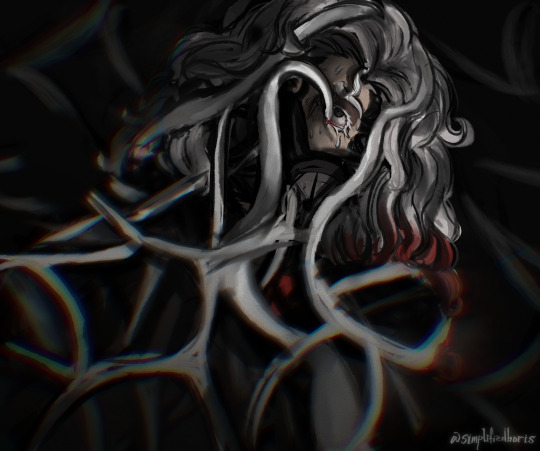
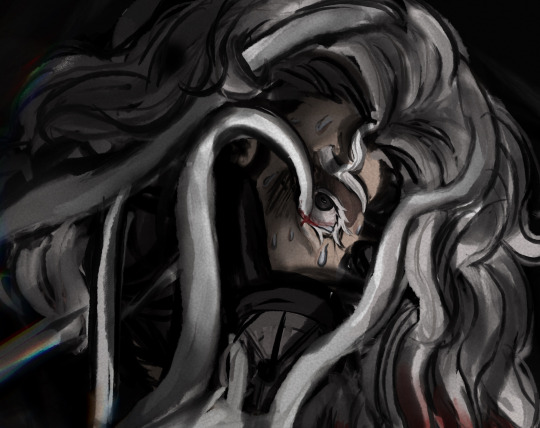
#identity v#identity v survivor#idv survivor#idv#simplifiedboris art#mod: boris#ada mesmer#idv ada#idv psychologist#idv fanart
23 notes
·
View notes
Text

IM SO NORMAL
#idv fanart#idv#identity v#identity v fanart#emil mesmer#ada mesmer#idv ada#idv emil#idv psychologist#idv patient#identity 5
80 notes
·
View notes
Text

Redraw of Emil’s birthday art because I love them
#identity v#identity v survivor#identity v fanart#identity v art#ada mesmer#emil mesmer#idv ada#idv emil#idv art#idv#idv psychologist#idv patient#fanart#my art#digital drawing#digital fanart#digital art#illustration
51 notes
·
View notes
Text

my gf btw
#ibispaintx#artists on tumblr#my art#idv fanart#idv#idv psychologist#ada mesmer#idv ada#idv ada mesmer#identity v psychologist#identity v ada#identity v fanart
43 notes
·
View notes
Text
Analysis of White Sand Street Asylum - Part 3
Includes Full Character Analyses for: Freddy, Kreacher, Emma, Emily, Leo, Robbie and Dolores, Kurt, Ada and Emil, Alice.
Beginning: Asylum Analysis Part 1
Previous: Asylum Analysis Part 2
Soon after, the evaluations begin.
1 of those being evaluated is Kurt Frank.
Kurt was born in Yorkshire, England to parents who, even when Kurt was young, constantly moved around. They went “from England to Italy, then to France, and then to England again”, with young Kurt always surrounded by “all kinds of adult travelers”. Unfortunately, his parents are described as never paying him much (if any) attention: “Whenever he looked up, he could only see the tight jawline of his parents and their hurried figures that never looked down”. As Kurt is described as “working class”, it is likely his parents were the type who spent all their time and energy on their work, and thus by the end of the day had none to spare for their son. This means they likely didn’t attempt to help Kurt to really understand all the foreign places they took him too. Based on how he was surrounded by “adult travelers”, it is likely much of what he encountered wasn’t a place for kids, and possibly due to his parents’ work.
Everything was huge, confusing, and overwhelming, leaving Kurt feeling “small and powerless and out of place”. This is no surprise considering the constant moving left Kurt with no stability, making him feel unsettled and disconnected, like he had no safe place to call home. He also had no guidance or support from his parents, leaving him feeling neglected amid chaos. And without any form of stability, he likely never stayed around in 1 place long enough to form any long-term relationships. Neither did he have much control over anything, as he was subject to his parents’ decisions.
Kurt’s backstory continues from here by saying “This early feeling of being ignored led Kurt Frank to develop a typical avoidant personality”. Avoidant personality disorder (APD) is characterized by severe and chronic social anxiety. People with this disorder have a long-standing pattern of social avoidance accompanied by hypersensitivity to negative evaluation (aka fear of criticism, rejection, ridicule, etc…) and low self-worth so pervasive that it defines who a person is. They will be easily and extremely hurt by any type of criticism in any situation. They avoid making new friends and trying new activities unless they’re absolutely sure they’ll be liked and accepted without rejection, criticism, or ridicule. They tend to be shy, quiet, “invisible” (aka tend to hide using their clothing or by staying in the background in social situations), and lonely, but they’re different from schizoid people. The avoidant person wants social contact but is afraid of rejection, whereas the schizoid or schizotypal person is completely indifferent to such contact.
Due to being ignored by his parents, Kurt turned to books to escape his reality and his fear of rejection. His backstory says it was also due to him having “trouble concentrating” and a disinterest in going outside. His favorite novel was Gulliver’s Travels, where he “imagined he was a great adventurer and refused to accept the actual situation”. In this world, he was the hero. There was no more feeling of not fitting in. A world where everyone accepted him. He was important. He received all the love and concern he wanted here. It was also a place where he could essentially design it however he wanted, and thus a place he understood perfectly well (compared to everything else).
Even though Kurt couldn’t make real friends, he was able to play with his imaginary ones, and his imaginary world continued to expand as he continued reading.
Eventually Kurt goes to college, but his “bushy mustache” causes him to argue with others often, leading to him being an “outlier”. Unable to get approval from others, this causes issues with his avoidant personality, and he starts avoiding going to school, something that disappoints his father. He attempted to stress the importance of college if Kurt wanted to be successful in the future, like they were, but Kurt didn’t care. He couldn’t handle the ridicule and rejection from his classmates. He couldn’t even talk about his problems to his parents because they didn’t understand nor care. They never had and they never would. His relationship with them had been strained for as long as he could remember, and this on top of his problems at school was overwhelming Kurt, who was left to handle it all on his own.
Without the proper emotional support or help from anyone, he funnels his emotions into horse racing, but Kurt “lacked the vision and brains to invest” and “lost all his living expenses and even owed a loan shark”.
This forces him to completely drop out of college. His parents, left with no choice, send him into the army hoping it would “correct his behavior”.
Initially, Kurt was likely quite unhappy with his situation. He didn’t want to deal with the increased social interactions, new people, new activities, and everything. But as usual, he didn’t have a choice. Fortunately, he had been able to bring his book with him, allowing him to escape from his new reality at least temporarily.
Eventually, Kurt decides to “boast” about his “adventure experience” to his comrades. There weren’t many ways for men at the barracks to amuse themselves with, especially when far from home and family, and Kurt thought this would “cheer everyone up”.
Initially, all goes well. The other men are “captivated” by his experiences, and he earns the attention and praise Kurt has always wanted, the approval he’s never received even from his own parents.
Unfortunately, it doesn’t last. The men eventually discover Kurt had been lying and the stories he shared were only from books he read, rather than experiences he actually lived through. His skills aren’t anywhere as good as he claimed, and the men in general don’t appreciate being tricked or lied to. Soon, Kurt becomes reviled and an outcast similar to how he’d been at college.
With Kurt’s avoidant personality once again triggered, his mental state deteriorates. He wants to prove them wrong. He wants them to know that he is a real explorer, and he has gone through all these things. He goes a bit off the deep end, and ends up getting into trouble.
Kurt had said he wanted to remain in the army for “as long as his health allowed”, but due to his increasing inability to differentiate between fantasy and reality, he is labeled as mentally ill and sent to White Sand Street Asylum. This is based on the title of deduction 9 being “Road-blocking ‘Dragons’” (dragons, like an enemy or threat), with the line “These giant, fanged...dragons! You can't stop an explorer!” essentially depicting him being taken away.
This is confirmed via the event Kurt’s Wondrous Journeys. In the event, he says White Sand Street is the center of his world. So, on the center of his map, he drew a circle to represent “the origin of my adventure, and surround it with triangles, representing trees” (via drawing a “1” under each triangle”). He later talks about people using “fears to stop you” and how “nothing but monsters and danger await you, should you ever leave”. It’s at this point he says, “If you turn these triangles upside down, they are the shape of a dragon's terrible fangs, a symbol of unknown terror, and the ultimate price—death” (and we know terror and death both happen at the asylum).
In the Asylum, we learn during his reassessment that he is indicated to have “Delusional Schizophrenia”. I’m not sure this is an actual thing, so I tried checking the translations of other versions (as best I as I could). So far, I think the more appropriate terms I saw were “delusions of grandeur” and “schizophrenia”.
Delusion of grandeur is a false belief in one’s power or importance. It may be a symptom of a mental health disorder and can cause confusion between what is real and what is not. The strength of a delusion is based on how much the person believes it. Specifically, a delusion of grandeur is a person’s belief that they are someone other than who they are, or a belief that they have special abilities, possessions, or powers.
Many types of mental health disorders can lead to delusions, including schizophrenia.
Schizophrenia is a complex disorder that causes people to interpret reality abnormally. They don’t know what sights, sounds, and experiences are real or what they are imagining. It usually involves delusions (false beliefs), hallucinations (seeing or hearing things that don’t exist), unusual physical behavior, and disorganized thinking and speech. With treatment, most symptoms of schizophrenia can greatly improve and reduce the likelihood of a reoccurrence.
In any case, Duke eventually asks Lorraine to discharge Kurt. Lorraine, who is currently the head of the asylum now that Duke has become a bishop, believes Kurt can’t be discharged due to the persistence of his delusions. Kurt claims “he had flown solo across the English Channel, possesses extraordinary survivalist skills, and is capable of the construction and operation of, including but not limited to, Blimps”. Lorraine adds that his delusions evolve “in a scale of grandiose when exposed to outside influences”. She worries, even though he is not violent now, he could pose a threat later due to his “deteriorating mental health stability and elevating delusions” and “eloquence in persuasion”.
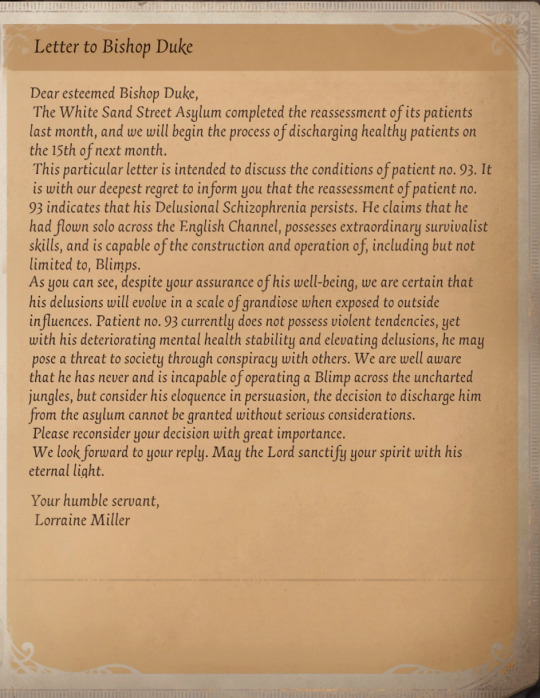
But Kurt has other ideas. He has no desire to remain in the asylum, which he starts thinking of like he’s back at school, and is willing to do anything if it means getting out.
Life at the asylum hasn’t gotten any better.
We see in Kurt’s Wondrous Journeys how he describes the place: a “great gray structure” whose interior is all that many of the patients “have ever known”. The corridors are “long” and “lined with heavy, iron doors”, behind which the patients live, awaiting “inspection” from the “King”.
The “King” card we have during this event shows one side looking like a king, but the other is a nun. The card reads “They try to use love to lock other people down”. It is clear the “King” here is meant to represent Lorraine.

1 of the things still limiting the patients’ freedom is the medicine, which is likely represented by “Tea Time”. They were given that medicine at the “beginning” of each day.

The size of the rooms for the patients behind the “heavy, iron doors” were likely “only 52 inches long”.

As another side note, one of the other cards is of a chair that may symbolize the same one Emma used when she was getting electroshock treatment. I wonder if it could imply he got electroshock treatment while he was there as well?
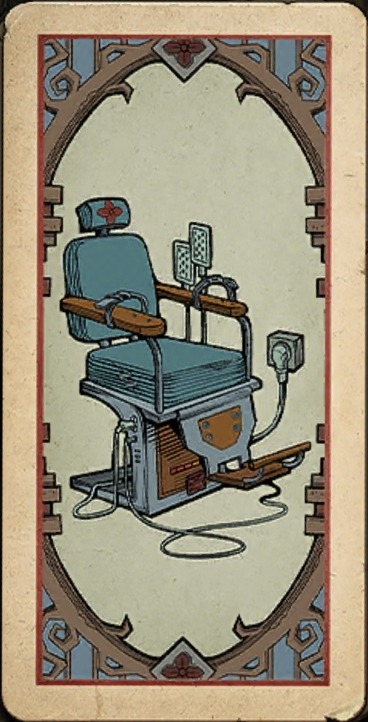
Either way, we know Kurt does eventually leave the asylum to go to the manor.
What we do have is Kurt’s deduction 11. It talks about a “battle between Don Quixote and the Biscayan up close”, after which Kurt says “Obviously, I managed to get out of there”. Don Quixote being the man obsessed with becoming a knight and reviving chivalry who, in his delusional state, charges at windmills he mistakes for giants. Biscayan, who’s passing by, thinks he’s mad and, misunderstanding the situation, challenges Don Quixote to a duel. Don Quixote, driven by his delusions of grandeur, manages to disarm the Biscayan. Kurt is likely to represent Don Quixote. The Biscayan, symbolizing a skilled opponent, could represent Lorraine, who is the one fighting to keep Kurt at the asylum.
Maybe this means that Lorraine lost her argument or “battle” to keep him there, thus implying Duke forced her to let him go (or maybe Kurt somehow reasoned with her himself, in something like a battle of wits, and via his “eloquence of persuasion” was able to convince her to let him go).
Kurt may have even been the first patient to leave, potentially the same one mentioned in the asylum backstory. This is important as, after this first person, Lorraine, according to the asylum backstory, left her resignation in her office and disappeared. The Church quickly moved the remaining patients from the White Sands Street Asylum and closed it down (as ordered by the government after the locals questioned if the asylum should be allowed after Dolores’ killing spree).

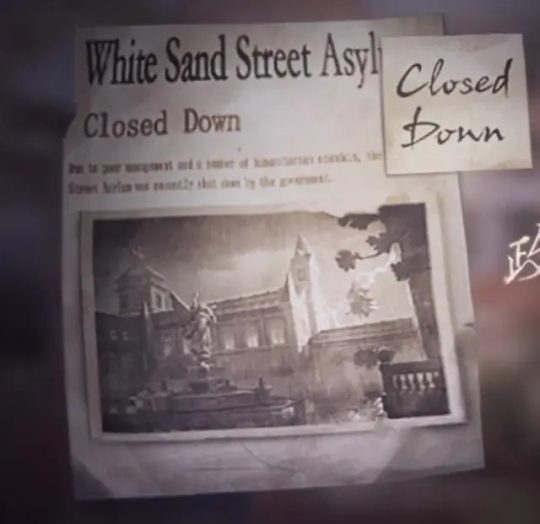
Before the asylum closes, the events of Ada’s and Emil’s stories occur, though I do not know exactly when.
Emil was the youngest son of a poor couple, where he had 3 other siblings. The mother seems to have been suffering from a type of mental illness, and it was difficult for Emil’s father to care for her as well as 4 kids. As a result, he sold his youngest to an underground dog fighting ring. His new owners at first didn’t care for him, but this all changed after Emil snuck into the pit and managed to make it out alive. His owners, seeing the reaction of the audiences, decided to continue to utilize him that way for more money, and Emil was forced to grow accustomed to this life, where he saw himself more as another dog than a person.
He’d never known real love. He’d only ever been seen as an object that others only saw in terms of how to get value for themselves. All Emil knew was if he wanted to survive, he had to fight for it, and so he did. Living conditions were horrid, with him being forced to live in a “kennel” with “shackles locked around his ankles” and barely enough food to sustain himself with, and what he was given was of poor quality. He also wasn’t given proper treatment for his wounds, which he acquired plenty of by the vicious dogs in the ring that would always attempt to tear him apart without restraint, or to ensure he stayed healthy. He was on his own. His owners didn’t care if he lived or died. If he did, they could just get another dog and continue on their merry way.
Emil wasn’t satisfied with being a “plaything of nobles” and always forced to survive the dog fighting ring, so one day he manages to escape. Unfortunately, he ends up with a high fever and forgets everything, and this is when he’s taken “by the asylum who defrauded charity funds”.

The asylum uses a “staggering amount of sedatives on its patients”, including sleeping pills and tranquilizers, to keep their patients under control and from being able to fight back. Emil is so high on these that he feels like he’s “floating away”. They do this as they diagnose Emil with “manic fits” and “severe aggressive tendencies”. This is why they keep his hand “cuffed to the bed” and lock him in “solitary confinements known as the ‘Cages’”, which is only for the “most dangerous patients”.


He suffers greatly due to their painful treatments, but he “always accepted being manipulated obediently”. And then everything starts to change when he meets Ada.
Ada, unlike Emil, was from a “relatively affluent middle-class family” where “every step in her life has been strictly planned” by her doctor father and teacher mother. She didn’t have much of a childhood, as she had “few playmates her own age” and spent most of her time “communicating with adults or reading”.
She is sent to university, where she enters “the school's psychological laboratory for research”. As a medical genius, she is awarded “the position of assistant professor of psychology”.
This is likely because her father had been training her from a young age and had her watching him since she was at least 13.
Ada has been researching hypnotherapy and the “idea of eliminating a patient's pain or negative emotions with subliminal suggestions”. This is likely the 1st time she’s actually chosen something for herself, yet no one, not even her own father, a “leading authority in psychiatry”, “had much faith in me”.
She explains the issues she had with her research: “The patients provided by the academy where I studied couldn't be hypnotized while they were in pain, and after countless failures… I had to devise a new method...”. Unfortunately, her “private experiment was discovered and those people pulled the plug on my research”.
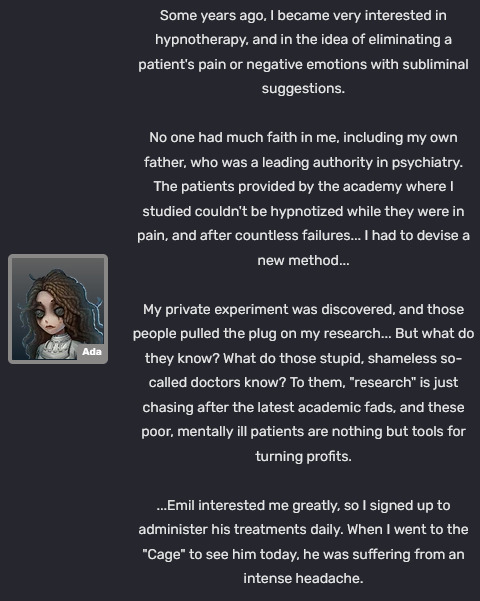
Ada thinks very lowly of other doctors who stop her from this research. Her goal is to help the mentally ill, while most other doctors just follow “the latest academic fads” and use the mentally ill for “turning profits”.
I imagine the reason for Ada’s desire to help people likely started due to her encounter 1st encounter with Emil, who she found starving in the street. She bought him bread, but her father refused to help Emil when she asked. Ada couldn’t understand why. I think from then she likely began to look down on her father’s actions. Her father was probably like the other doctors, someone who followed the latest “fads”, was primarily interested in profit, and utilized treatments that Ada wouldn’t always agree with, just like how she looks down on what the asylum is doing.
Ada says she used to utilize the same methods in the past, but “that was a long time ago”. This could also refer to potentially what she used to do in her desperation for her hypnotherapy experiments at college to work, before the plug was pulled. That would explain why she’d describe “tormenting patients for the sake of my research”.
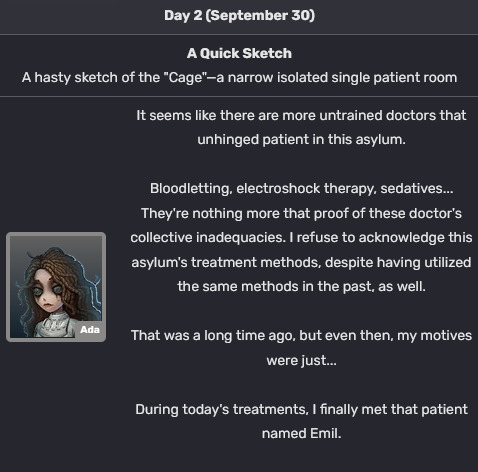
Not giving up, Ada travels to various hospitals and clinics, looking for some place where she can carry out her experiments and hopefully find a patient who will give her success.
It’s during this period that Ada goes to White Sand Street Asylum for an “eleven-day medical training program here”.
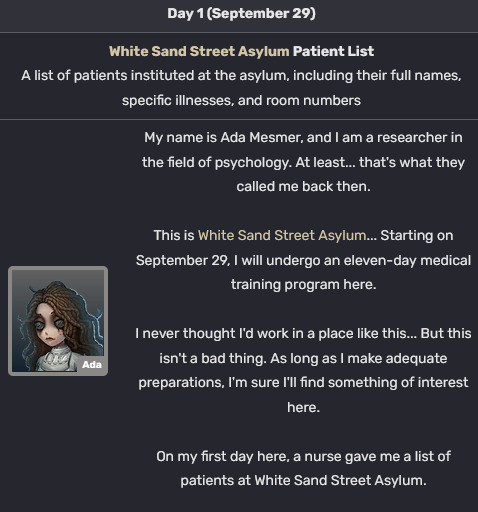
While looking at the list of patients, specifically at those labeled dangerous, she notices “a person without a surname on the list, Emil”. She watched the doctors give him electroshock therapy, and how, unlike other patients, he “didn't seem as terrified”. “When his treatment was over, he even smiled at the doctors... A mindless, yet eerily natural smile...”. She’d never seen someone react like this: “He didn't try to avoid or resist the pain inflicted on him. Even though his consciousness was tenuous at best, he instinctively showed signs of joy”.

Eventually, she finds herself alone with Emil, who was “trembling and gasping violently”. Taking a chance, she found that “when I blew my whistle, he would become surprising calm”. Ada figures out his past based on the only possession Emil had been found with, a dog collar, and why he reacts the way he does to the whistle.
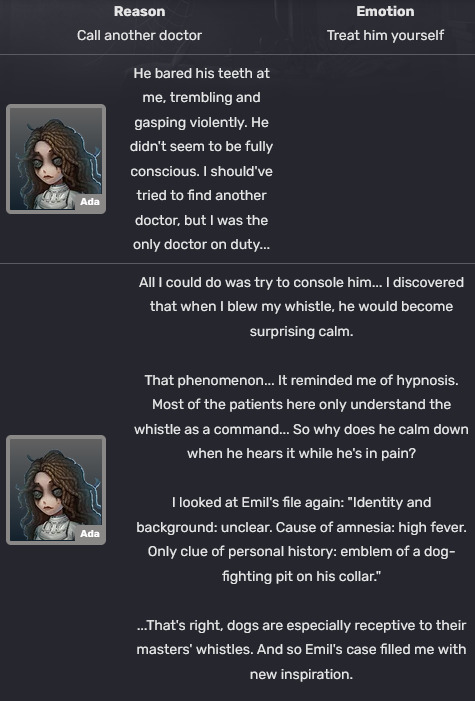
Emil is the first person Ada’s encountered who could “respond to hypnotism while under intense pain”, which was part of the reason her experiments had failed in the past. It is at this point she decides to mess with the medications the asylum was giving Emil, so Emil could be more “cognizant” even though it’d bring “greater pain”. The next day, Emil does suffer more from the electroshock therapy, but just like before, he calms down once he hears Ada’s whistle. Ada is ecstatic to finally find the “perfect candidate for my experiments”.
Ada gradually reduces his medication over the next few days. Once he was conscious enough, she tells him she’d taken away his pain medication. Ada is conflicted, and wonders if what she’s doing is alright, and seeks answers for herself based on whether Emil forgives her. When she asks him “Ada or medicine”, he responds with “Ada” despite Emil knowing this meant more pain, which relieves her worries and makes her feel “elated beyond words”.
Despite the fact Ada initially only saw Emil only in terms of him being a perfect candidate for her experiments, she gradually starts to “develop feelings for him”. She knows she is going to have to leave soon, but due to the fact she’d grown quite attached to him, she decides she wants him to leave with her.

Emil is grateful to Ada for her helping to wake him up. He says he’s stopped experiencing the nightmare about his past that’s plagued him “for as long as I can remember”. And so, when he receives a gift of a flower from her one day, not knowing what was a proper way to react in response to getting a gift, fashions a ring for her from his bed wire.

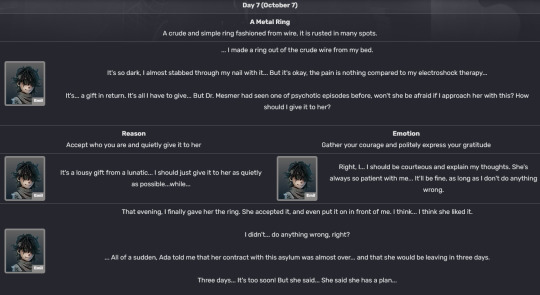
Ada is touched by his return gift, as this was the “first time a patient had shown me understanding and gratitude”. This only hardens her resolve to get him out of the asylum.
As they prepare to make their escape at dawn, Ada mentions the staff will be on high alert until then because a patient, a “young girl” managed to escape from the asylum. This is likely to be Lisa, who we know escapes from the asylum based on the fact she is using a fake name to hide her identity.

Eventually, the 2 do manage to escape from the asylum. Ada takes them to a “new home” that’s “faraway” with “no people around” and requires “getting there in a car”.
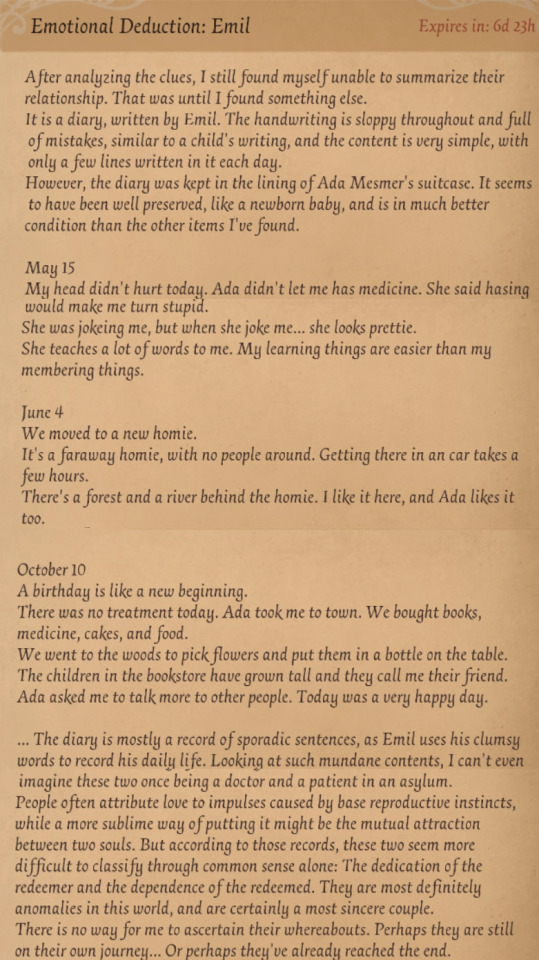
They live like this for 3 years, but unfortunately, Emil starts growing worse. “Emil has begun to have frequent headaches again, and his self-awareness is declining...I can't watch him lose himself and go back to the pathetic way he was before. I can't lose him again, my one and only love...”. His other symptoms include “Anxiety disorder, OCD, hallucinations, dementia, and recurring night terrors”.
One potential solution to her current issue comes in the form of Orpheus, who Ada 1st met while at the asylum. Orpheus is offering to try the “latest treatment” on Emil in exchange for Ada giving Orpheus the list of patient files of White Sand Street Asylum. Ada is skeptical at first, and initially directs him to her father’s clinic, who she says may be “the type of doctor who will get along with you”. This I think is a bit of sarcasm to imply she thinks him and her father are both the bad type of people/doctor that she doesn’t like. She did say she didn’t believe in his “method of finding inspiration from patients in the asylum”. However, after some amount of time and Emil’s condition only worsens, she decides to eventually agree to the deal and heads to the manor.
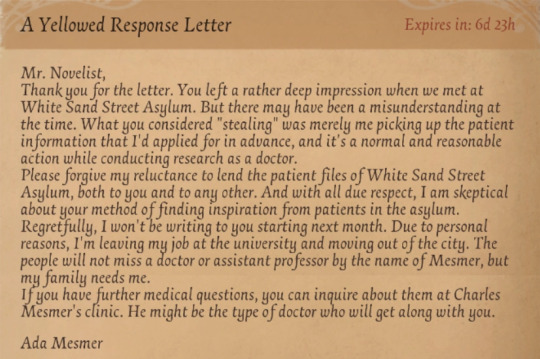

Besides potentially as “inspiration” for his novels, another reason Orpheus is likely interested in the patients of the asylum is because that is where Alice was sent. After the tragedy that killed Alice’s parents in 1887, Alice was sent to the asylum due to her supposedly having gone “insane”.

Orpheus wants to visit her, but is declined because Alice is currently “unstable” and they want to “minimize external stimulation” since he would remind her of “what happened in the past” which “wasn’t a great memory to her”. Instead, they tell him a “kind individual” took notice and “offered a significant amount of financial assistance to the orphanage and put together an excellent treatment package designed exclusively for Alice”.
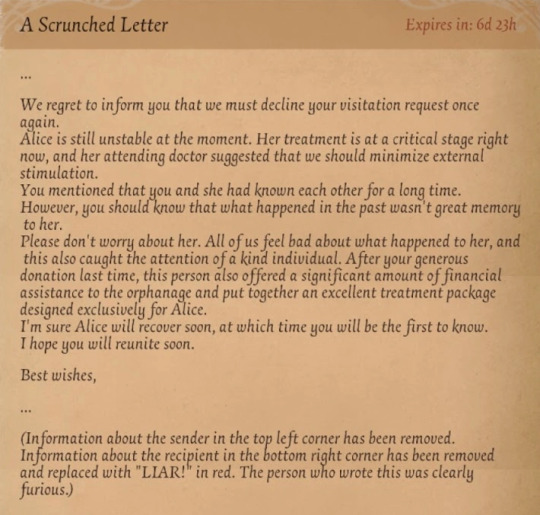
Orpheus is less than enthused as he writes “LIAR!” at the bottom of the letter. But we also know Orpheus to an extent was right as Alice “experienced both mental and physical torture in the orphanage” (aka the asylum).
This “individual” was Villhelm Lamb, a “medical professor” that “secretly adopted” her for the purpose of using her as an “experimental subject”. It was for this reason that he took her to “Melbourne when she was 14 years old”.

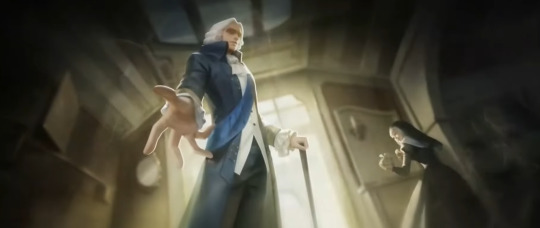
Her backstory states “With prolonged medication and physical therapy, she gradually regained consciousness, however, it is perhaps more cruel to live soberly in hell than to live unaware in human world”. But as we can see from flashes of her past, this wasn’t a very happy time due to all the experiments she was subjected to.

We can see that some of the drugs used on Alice included Mnemosyne and Siren’s Song. Mnemosyne is the drug that makes a person forget, and considering what we heard in Orpheus’ letter from the asylum, it is likely they were trying to make her forget the tragedy (potentially as a way to stabilize her). Siren’s Song is the hallucinogenic. Maybe they were giving her this as another way to somehow help her regain her mental stability (unless this was a mistake, but I’m not sure).


We can also see one of the people shown working on Alice includes someone who looks strikingly like Orpheus, so it’s likely he somehow managed to get himself involved to see Alice again and may be wanting to do this to her as some way to help (though it is clear this isn’t entirely a good thing and Alice wants to get away).

In any case, Alice does eventually manage to escape back to England when she’s 21, where she becomes a “social journalist in anonymity, looking for the truth about the tragedy and the disappearance of her playmates”.
We can see from her deductions though that someone likely wants to eliminate Alice. Considering the similarities, I believe it’s possible whoever this is has hired the crime syndicate that was first mentioned during Luchino’s 1st letter to go after her, with their conclusion being she needs eliminated.
Alice’s deductions 8-10 appear to be written by a different author than the one who wrote 1-7, meaning it is likely no longer the crime syndicate talking, meaning whoever hired the syndicate has hired someone else to go after Alice. This new hired person seems to suspect that Orpheus and Alice are “much closer than expected” based on Alice’s deduction 8. Considering Norton’s 2nd letter, it is possible he is this new person hired to go after Alice. There’s also how this person says they initially believed Alice’s “recklessness and bravery were just a front”, which is very similar to how Norton calls the female he was to target as “arrogant”, before Alice’s deduction 9 continues by saying they realize this was a mistake, “it is neither a front nor bravery”. This is likely because Alice’s “sense of fear” is “significantly weaker than normal” after the experiments Villhelm put her through. The last deduction, where it asks what the subject thinks she saw vs what she actually saw, which can relate to how during Ashes of Memory Alice sees Mary and Fool’s Gold instead of Frederick and Norton.
#idv#identity v#freddy riley#kreacher pierson#emma woods#emily dyer#leo beck#robbie white#kurt frank#ada mesmer#emil#alice deross#idv freddy#idv kreacher#idv emma#idv emily#idv leo#idv robbie#idv kurt#idv ada#idv emil#idv alice#idv lawyer#idv thief#idv gardener#idv doctor#idv hell ember#idv axe boy#idv explorer#idv psychologist
26 notes
·
View notes
Text
i love her doomsday rescuer beta design
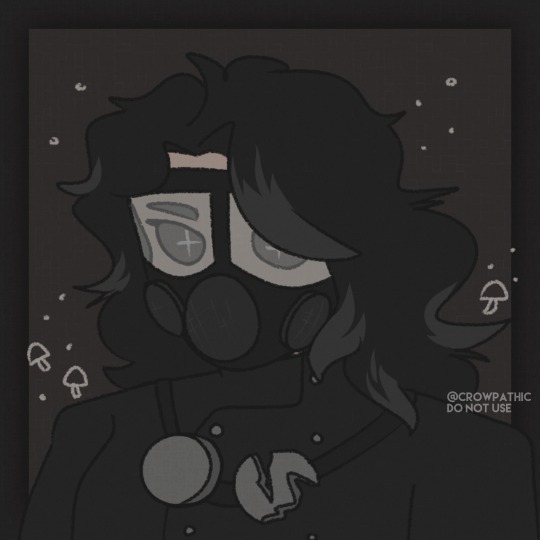
20 notes
·
View notes
